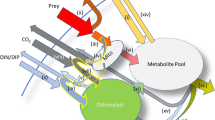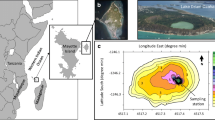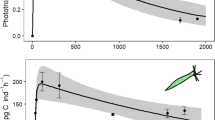Abstract
Mixotrophy is a combination of photosynthesis and direct access to organic carbon sources, mainly through osmotrophy or phagotrophy. This strategy is adopted by several, phylogenetically distinct, phytoplankton groups and is commonly occurring in marine, brackish and freshwater ecosystems. Traditionally, it has been put in relation to both scarcity of inorganic nutrients and poor light conditions. However, we observed blooms of the mixotrophic, toxic haptophyte Prymnesium parvum in different periods of the year and under variable resources availability. The analysis of a 6.5-year data set of phytoplankton weekly records from a Sicilian shallow lake (Biviere di Gela, south-eastern Sicily) allowed us to hypothesise that a depleted condition as regards inorganic nutrients is not the main fuel to the growth of P. parvum, neither this is due to light limitation. The results achieved show that an increased availability in suitable preys can stimulate the growth of this phagotrophic photoautotroph. Contemporarily, it was not found any clear environmental patterns to explain species dominance and growth patterns as related to inorganic nutrient availability. Moreover, it is shown that these organisms tend to monopolise resources when these become available irrespective of seasons, and under variable conditions as regards inorganic nutrient availability.





Similar content being viewed by others
References
APAT, 2003. Metodi Analitici per le Acque. Manuali e Linee Guida 29/2003. Agenzia per la Protezione dell’Ambiente e per i Servizi Tecnici, Roma. ISBN 88-448-0083-7 [available on internet at http://www.isprambiente.gov.it/it/pubblicazioni/manuali-e-linee-guida/metodi-analitici-per-le-acque].
Arenovski, A. L., E. L. Lim & D. A. Caron, 1995. Mixotrophic nanoplankton in oligotrophic surface waters of the Sargasso Sea may employ phagotrophy to obtain major nutrients. Journal of Plankton Research 17: 801–820.
Azam, F., T. Fenchel, J. G. Field, J. S. Gray, L. A. Meyer-Reil & F. Thingstad, 1983. The ecological role of water-column microbes in the sea. Marine Ecology Progress Series 10: 257–263.
Barone, R. & L. Naselli-Flores, 2003. Distribution and seasonal dynamics of Cryptomonads in Sicilian water bodies. Hydrobiologia 502: 325–329.
Barone, R., G. Castelli & L. Naselli-Flores, 2010. Red sky at night cyanobacteria delight: the role of climate in structuring phytoplankton assemblage in a shallow, Mediterranean lake (Biviere di Gela, southeastern Sicily). Hydrobiologia 639: 43–53.
Burkholder, J. M., P. M. Glibert & H. M. Skelton, 2008. Mixotrophy, a major mode of nutrition for harmful algal species in eutrophic waters. Harmful Algae 8: 77–93.
Caron, D. A., R. W. Sanders, E. L. Lim, C. Marrasé, L. A. Amaral, S. Whitney, R. B. Aoki & K. G. Porter, 1993. Light-dependent phagotrophy in the freshwater mixotrophic crysophyte Dinobryon cilindricum. Microbial Ecology 25: 93–111.
Croft, M. T., M. J. Warren & A. G. Smith, 2006. Algae need their vitamins. Eukaryotic Cell 5: 1175–1183.
Eikrem, W., L. K. Medlin, J. Henderiks, S. Rokitta, B. Rost, I. Probert, J. Throndsen & B. Edvardsen, 2017. Haptophyta. In Archibald, J. M., A. G. B. Simpson & C. H. Slamovits (eds), Handbook of the Protists, 2nd ed. Springer, Cham: 893–953.
Eiler, A., 2006. Evidence for the ubiquity of mixotrophic bacteria in the upper ocean: implications and consequences. Applied and Environmental Microbiology 72: 7431–7437.
Ghyoot, C., K. J. Flynn, A. Mitra, C. Lancelot & N. Gypens, 2017. Modeling plankton mixotrophy: a mechanistic model consistent with the Shuter-type biochemical approach. Frontiers in Ecology and Evolution. https://doi.org/10.3389/fevo.2017.00078.
Granéli, E. & N. Johansson, 2003. Increase in the production of allelopathic substances by Prymnesium parvum cells grown under N- or P-deficient conditions. Harmful Algae 2: 135–145.
Händeler, K., Y. P. Grzymbowski, P. J. Krug & H. Wägele, 2009. Functional chloroplasts in metazoan cells – a unique evolutionary strategy in animal life. Frontiers in Zoology. https://doi.org/10.1186/1742-9994-6-28.
Hillebrand, H., C.-D. Dûrselen, D. Kirschtel, U. Pollingher & T. Zohary, 1999. Biovolume calculation for pelagic and benthic microalgae. Journal of Phycology 35: 403–424.
Hoef-Hemden, K. & J. M. Archibald, 2017. Cryptophyta (Cryptomonads). In Archibald, J. M., A. G. B. Simpson & C. H. Slamovits (eds), Handbook of the Protists, 2nd ed. Springer, Cham: 851–891.
Jeppesen, E., S. Brucet, L. Naselli-Flores, E. Papastergiadou, K. Stefanidis, T. Nõges, P. Nõges, J. L. Attayde, T. Zohary, J. Coppens, T. Bucak, R. F. Menezes, F. R. S. Freitas, M. Kernan, M. Søndergaard & M. Beklioğlu, 2015. Ecological impacts of global warming and water abstraction on lakes and reservoirs due to changes in water level and related changes in salinity. Hydrobiologia 750: 201–227.
Johnson, M. D., D. J. Beaudoin, A. Laza-Martinez, S. T. Dyhrman, E. Fensin, S. Lin, A. Merculief, S. Nagai, M. Pompeu, O. Setälä & D. K. Stoecker, 2016. The genetic diversity of Mesodinium and associated cryptophytes. Frontiers in Microbiology. https://doi.org/10.3389/fmicb.2016.02017.
Jones, H. J. L., 1997. A classification of mixotrophic protists based on their behaviour. Freshwater Biology 37: 35–43.
Jones, R. I., 2000. Mixotrophy in planktonic protists: an overview. Freshwater Biology 45: 219–226.
Jones, H., C. S. Cockell, C. Goodson, N. Price, A. Simpson & B. Thomas, 2009. Experiments on mixotrophic protists and catastrophic darkness. Astrobiology 9: 563–571.
Kagalou, I., G. Tsimarakis & E. Bezirtzoglou, 2002. Inter-relationships between bacteriological and chemical variations in Lake Pamvotis – Greece. Microbial Ecology in Health and Disease 14: 37–41.
Keeling, P. J., 2013. The number, speed, and impact of plastid endosymbioses in eukaryotic evolution. Annual Review of Plant Biology 64: 583–607.
Leander, B. S., G. Lax, A. Karnkowska & A. G. B. Simpson, 2017. Euglenida. In Archibald, J. M., A. G. B. Simpson & C. H. Slamovits (eds), Handbook of the Protists, 2nd ed. Springer, Cham: 1047–1088.
Litchman, E. & C. A. Klausmeier, 2008. Trait-based community ecology of phytoplankton. Annual Review of Ecology, Evolution, and Systematics 39: 615–639.
Mitra, A., K. J. Flynn, U. Tillmann, J. A. Raven, D. Caron, D. K. Stoecker, F. Not, P. J. Hansen, G. Hallegraeff, R. Sanders, S. Wilken, G. McManus, M. Johnson, P. Pitta, S. Våge, T. Berge, A. Calbet, F. Thingstad, H. J. Jeong, J.-A. Burkholder, P. M. Glibert, E. Granéli & V. Lundgren, 2016. Defining planktonic protist functional groups on mechanisms for energy and nutrient acquisition: incorporation of diverse mixotrophic strategies. Protists 167: 106–120.
Naselli-Flores, L., 1999. Limnological aspects of Sicilian reservoirs: a comparative ecosystemic approach. In Tundisi, J. G. & M. Straškraba (eds), Theoretical Reservoir Ecology and its Applications. Backhuys Publishers, Leiden: 283–311.
Naselli-Flores, L., 2000. Phytoplankton assemblages in twenty-one Sicilian reservoirs: relationships between species composition and environmental factors. Hydrobiologia 424: 1–11.
Naselli-Flores, L., 2014. Morphological analysis of phytoplankton as a tool to assess ecological state of aquatic ecosystems: the case of Lake Arancio, Sicily, Italy. Inland Waters 4: 15–26.
Naselli-Flores, L. & R. Barone, 1994. Relationship between trophic state and plankton community structure in 21 Sicilian dam reservoirs. Hydrobiologia 275(276): 197–205.
Naselli-Flores, L. & R. Barone, 2011. Fight on plankton! Or, phytoplankton shape and size as adaptive tools to get ahead in the struggle for life. Cryptogamie Algologie 32: 157–204.
Naselli-Flores, L. & R. Barone, 2012. Phytoplankton dynamics in permanent and temporary Mediterranean waters: is the game hard to play because of hydrological disturbance? Hydrobiologia 698: 147–159.
Naselli-Flores, L., R. Termine & R. Barone, 2016. Phytoplankton colonization patterns. Is species richness depending on distance among freshwaters or on their connectivity? Hydrobiologia 764: 103–113.
Obrador, B. & J. L. Pretus, 2008. Light regime and components of turbidity in a Mediterranean coastal lagoon. Estuarine, Coastal and Shelf Science 77: 123–133.
Olutiola, P. O., K. O. Awojobi, O. Oyedeji, A. D. V. Ayansina & O. O. Cole, 2010. Relationship between bacterial density and chemical composition of a tropical sewage oxidation pond. African Journal of Environmental Science and Technology 4: 595–602.
Pållson, C. & W. Granéli, 2004. Nutrient limitation of autotrophic and mixotrophic phytoplankton in a temperate and tropical humic lake gradient. Journal of Plankton Research 26: 1005–1014.
Raven, J. A., 1997. Phagotrophy in phototrophs. Limnology and Oceanography 42: 198–205.
Rengefors, K., A. Kremp, T. B. H. Reusch & M. Wood, 2017. Genetic diversity and evolution in eukaryotic phytoplankton: revelations from population genetic studies. Journal of Plankton Research 39: 165–179.
Reynolds, C. S., 2006. The Ecology of Phytoplankton. Cambridge University Press, Cambridge.
Reynolds, C. S., V. L. Huszar, C. Kruk, L. Naselli-Flores & S. Melo, 2002. Towards a functional classification of the freshwater phytoplankton. Journal of Plankton Research 24: 417–428.
Roelke, D. L., A. Barkoh, B. W. Brooks, J. P. Grover, K. D. Hambright, J. W. LaClaire II, P. D. R. Moeller & R. Patino, 2016. A chronicle of a killer alga in the west: ecology, assessment, and management of Prymnesium parvum blooms. Hydrobiologia 764: 29–50.
Saldarriaga, J. F. & F. J. R. M. Taylor, 2017. Dinoflagellata. In Archibald, J. M., A. G. B. Simpson & C. H. Slamovits (eds), Handbook of the Protists, 2nd ed. Springer, Cham: 625–678.
Simpson, A. G. B., C. H. Slamovits & J. M. Archibald, 2017. Protist diversity and eukaryote phylogeny. In Archibald, J. M., A. G. B. Simpson & C. H. Slamovits (eds), Handbook of the Protists, 2nd ed. Springer, Cham: 1–21.
Stoecker, D. K., 1998. Conceptual models of mixotrophy in planktonic protists and some ecological and evolutionary implications. European Journal of Protistology 34: 281–290.
Tanifuji, G. & N. T. Onodera, 2017. Cryptomonads: a model organism sheds light on the evolutionary history of genome reorganization in secondary endosymbiosis. Advances in Botanical Research 84: 263–320.
Tartari, G. A. & R. Mosello, 1997. Metodologie analitiche e controlli di qualità nel laboratorio chimico dell’Istituto Italiano di Idrobiologia. Documenta dell’Istituto Italiano di Idrobiologia 60: 1–160.
Tranvik, L. J., K. G. Porter & J. M. Sieburth, 1989. Occurrence of bacterivory in Cryptomonas, a common fresh-water phytoplankter. Oecologia 78: 473–476.
Yafremava, L., M. Wielgos, S. Thomas, A. Nasir, M. Wang, J. E. Mitthenthal & G. Caetano-Anollés, 2013. A general framework of persistence strategies for biological systems helps explain domains of life. Frontiers in Genetics. https://doi.org/10.3389/fgene.2013.00016.
Zimmer, C., 2009. On the origin of eukaryotes. Science 325: 666–668.
Author information
Authors and Affiliations
Corresponding author
Additional information
Guest editors: Hugo Sarmento, Irina Izaguirre, Vanessa Becker & Vera L. M. Huszar / Phytoplankton and its Biotic Interactions
Electronic supplementary material
Below is the link to the electronic supplementary material.
Rights and permissions
About this article
Cite this article
Naselli-Flores, L., Barone, R. Mixotrophic phytoplankton dynamics in a shallow Mediterranean water body: how to make a virtue out of necessity. Hydrobiologia 831, 33–41 (2019). https://doi.org/10.1007/s10750-018-3507-1
Received:
Revised:
Accepted:
Published:
Issue Date:
DOI: https://doi.org/10.1007/s10750-018-3507-1




